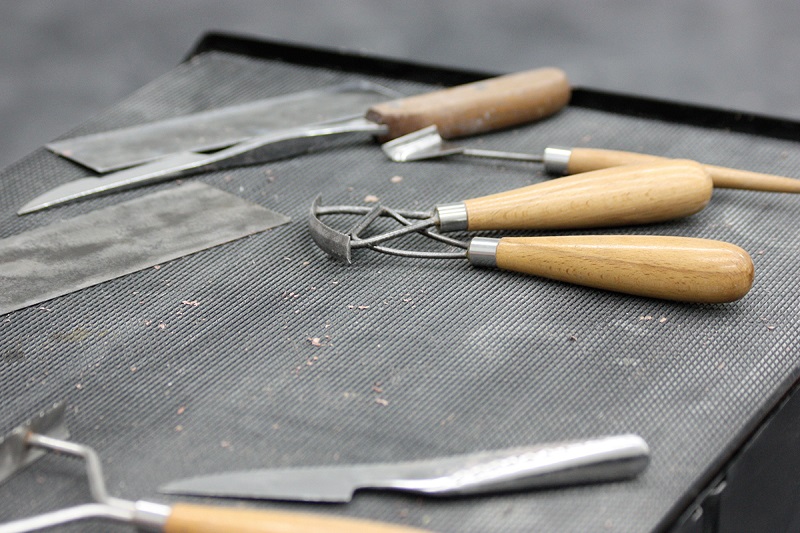Sculpturing is a demanding artwork that requires talent, time and dedication. Also, it requires having the right sculpture materials such as clay and tools. If you’re a beginner and want to create your modelling materials collection, but you’re on a budget, there are tools you can get and do the job like a pro. Here are the most important things you’ll need to become the next Michaelangelo.
Materials for Sculpture Processes

Modelling clay refers to a group of pliable products used for sculpting and building by art students, professional potters, animators, as well as hobbyists and children. You can shape modelling clay and manipulate it by using a variety of sculpting tools, such as scrapers, blending tools, pokers, texturing tools, thinning tools, and cutting tools.
- Oil-based clay – This type, also known as plasticine, originated in Germany in the 1880s. It possesses unique properties that make it highly useful for sculpting. Unlike pottery clay and wax, oil-based clay remains soft and workable. It does not require hardening or drying.
- Polymer clay – Polymer clay comes in various forms and under different brand names, each with different levels of softness at room temperature. Different types of polymer clay can be mixed to create desired properties. Combining softer polymer clay with firmer clay results in a stiffer final product. Once the sculpting process is complete, polymer clay should be baked in an oven at a temperature of 129°–135°C for 15 minutes per 6mm of thickness.
- Pottery clay – Pottery clay is a commonly used material for pottery and stoneware. It requires both handwork and the use of a pottery wheel. Once the sculpting process is finished, the clay should be allowed to air dry and then fired in a kiln. Various glazes, including glossy, matte, and specialty finishes, can be applied to pottery clay. These glazes are baked during the firing process. Low-fire and high-fire clays and glazes are available.
- Dough modelling clay- Dough modelling clay, also known as playdough, can be either edible or inedible. It can be easily made at home using cooked or uncooked versions. If you are looking for a material for a hobby or your children, dough modelling clay is an excellent choice. It is the least expensive option, as it only requires flour, cornstarch, cream of tartar, water, and oil. Food colouring can be added if the clay is intended for consumption or non-edible colouring can be used.
What Tools Do You Need to Get?

Wooden Carving/Shaping Tools
When purchasing your modelling materials, don’t forget to start with suitable tools for carving and shaping your sculptures. Wooden tools are commonly available and cost-effective, making them a suitable choice for beginners without straining their budget. These tools feature zigzag ridges that allow for the creation of textured effects in your work. However, if you require smooth details, tools with oval and rounded edges are also available. If you are new to the art of sculpting, it is not necessary to purchase all the tools you come across. Over time, you can gradually expand your collection. To begin, it is advisable to purchase the basic rounded tools and experiment with their functionality.
Plastic Tools
Plastic tools are also a cost-effective option for carving and shaping and offer durability. One advantage is that they are easy to clean (compared to wood, which may require more time for cleaning and drying). Furthermore, due to their naturally smooth surface, plastic tools allow for easy cutting, spreading, and creation of intricate details. It is recommended to test both wood and plastic tools to determine which material suits your needs better.
Double Ended Ribbon Tool
This one is available in both single-ended and double-ended versions. It’s crafted from wood and features hollow stainless steel scoops at both ends, making it ideal for intricate work. The scoops come in both round and square shapes, allowing for precise carving of hollow areas.
Needle Tool
The needle tool is designed for etching cross marks, joining coils of clay together, or roughing up the surface of the clay to enhance its adhesive properties. It is equipped with a sharp tip and comes with a protective cap. Additionally, it can be used to etch one’s signature onto clay work.
Loop Tool
This one is similar to the double-ended ribbon tool, but it is larger and has only one end. It is particularly useful for hollowing out clay in various areas, as its wide opening allows for the removal of larger chunks of clay. This tool is recommended for larger pieces of work, such as life-size busts.
Sponge
A simple yellow sponge can be quite useful when engaging in projects that need more than a day to complete. Sculpturing kits often include a sponge, which can be moistened to rehydrate the areas being worked on. While synthetic sponges are available, actual sea life sponges can also be effective, albeit at a slightly higher cost.
Potter’s Rib
The potter’s rib is a small tool that resembles a garden spade or a shark tooth. It has a small hole in the centre and is utilized by potters when working with a slab on the wheel to achieve a smoother finish. While not an obligatory tool, it can greatly assist in subsequent work.
Cutoff Wire
A cutoff wire with wooden handles serves as a valuable tool for slicing clay slabs. Simply hold the handles with both hands and indicate the desired amount of clay to be removed. This practical tool is highly recommended for artists who plan to do larger projects.
Scrapers
Scrapers are metallic devices that function similarly to potter’s ribs with the added benefit of producing cleaner edges around objects. They are quite handy in situations such as paint spills, where they can achieve a superior outcome compared to a plastic knife. Use it during the final stages of your work to refine and smoothen the surface before it gets dry.


Leave a comment